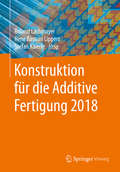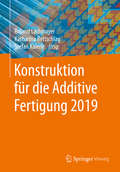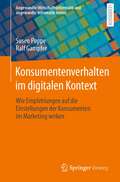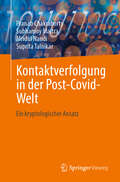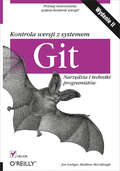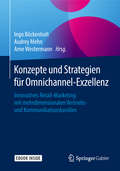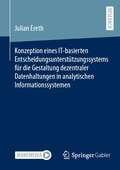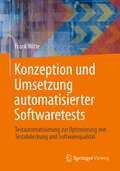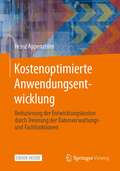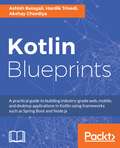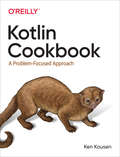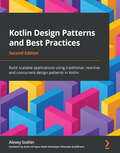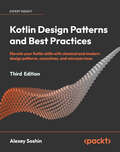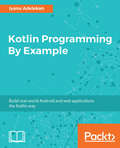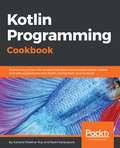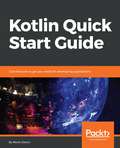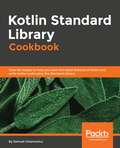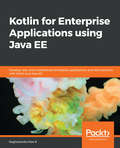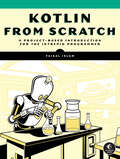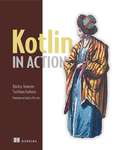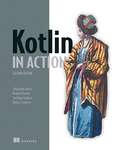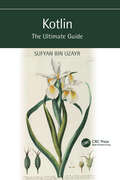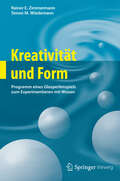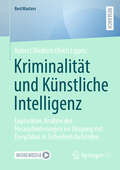- Table View
- List View
Konstruktion für die Additive Fertigung 2018
by Roland Lachmayer Rene Bastian Lippert Stefan KaierleDas Buch beschreibt grundlegende Spezifikationen von Bauteilen und Prozessen, Methoden zur Abschätzung der Bauteileignung und Anwendung der Additiven Fertigung sowie zur Entwicklung von Konzepten und Entwürfen. Weiter werden die Konstruktion von Bauteilen, deren Gestaltung zur Sicherstellung funktionaler Anforderungen und der Herstellbarkeit sowie Methoden und Werkzeuge zur Bauteiloptimierung dargestellt. Es erfolgt die Beschreibung von Ansätzen zur rechnergestützten Simulation sowie physischen Validierung von Bauteilen und die Erprobung von Bauteilen und Materialien. Daraus abgeleitet werden Maßnahmen zur Sicherstellung von Qualitätsaspekten charakterisiert. Weiterhin werden die Integration von Additiven Fertigungsverfahren in bestehende Prozesse dargestellt sowie Maßnahmen zur Steigerung der Wertschöpfung abgeleitet. Die Inhalte werden vor dem Hintergrund zum Aufbau neuer Geschäftsmodelle diskutiert, sie wurden 2018 auf einem Workshop präsentiert und zwischen Experten aus Forschung und Industrie erörtert.
Konstruktion für die Additive Fertigung 2019
by Roland Lachmayer Stefan Kaierle Katharina RettschlagDieses Buch thematisiert grundlegende Spezifikationen von Bauteilen und Prozessen, Methoden zur Abschätzung der Bauteileignung und Anwendung der Additiven Fertigung sowie zur Entwicklung von Konzepten und Entwürfen. Der Inhalt ist in vier Schwerpunktkapitel unterteilt: Zuerst wird auf die Integration additiver Fertigungsverfahren in bestehende Prozesse und Maßnahmen zur Steigerung der Wertschöpfung eingegangen. Nachfolgend sind Konstruktionen von Bauteilen, deren Gestaltung zur Sicherstellung funktionaler Anforderungen und Herstellbarkeit sowie Methoden zur Bauteiloptimierung dargestellt. Weiterhin werden Ansätze zur rechnergestützten Simulation sowie physischen Validierung von Bauteilen und deren Erprobung beschrieben. Daraus abgeleitet werden Maßnahmen zur Sicherstellung von Qualitätsaspekten charakterisiert. Die kapitelübergreifenden Inhalte werden vor dem Hintergrund zum Aufbau neuer Geschäftsmodelle diskutiert und legen den aktuellen Stand der Forschung im Bereich der Additiven Fertigung dar. Dieser Konferenzband baut auf den Inhalten des Vorjahresbandes "Konstruktion für die Additive Fertigung 2018" auf.
Konstruktion für die Additive Fertigung 2020
by Roland Lachmayer Stefan Kaierle Katharina RettschlagDie Additive Fertigung hat seit Jahren Ihren Status als Technologie zum Rapid Prototyping überwunden und Einzug in die Serienfertigung von Bauteilen, Werkzeugen und Ersatzteilen gehalten. Diese disruptiv veränderte Perspektive auf die Technologien der Additiven Fertigung führt zu Herausforderungen für Material- und Prozessentwicklung, aber vor allem zu Chancen für völlig neue Lösungen in der Konstruktion, durch z. B. bionische Formgebung, integrierte Effekte und gradierte Materialien.Dieses Buch gibt im Kontext einen Einblick in die aktuelle Forschung und Entwicklung zum Thema „Konstruktion für die Additive Fertigung 2020“ im deutschsprachigen Raum und wendet sich an Experten in Forschung und Wirtschaft. Es verschriftlicht die Vorträge und Diskussionen auf unserem diesjährigen Workshop am Laserzentrum Hannover e.V. mit den Schwerpunkten: Spezifikation von Bauteilen und Prozessen, Methoden zur Abschätzung der Bauteileignung, Innovative Anwendungen der Additiven Fertigung sowie Entwicklung von Konzepten und Entwürfen. Der Workshop wurde unterstützt durch Niedersachsen Additiv und die Wissenschaftliche Gesellschaft für Produktentwicklung e.V.
Konsumentenverhalten im digitalen Kontext: Wie Empfehlungen auf die Einstellungen der Konsumenten im Marketing wirken (Angewandte Wirtschaftsinformatik und angewandte Informatik lernen)
by Susen Poppe Ralf GampferDieses Buch gibt einen ersten Einblick in die Grundlagen des Marketings, insbesondere des Konsumentenverhaltens und betrachtet anschließend, inwieweit sich der digitale Kontext speziell auf das Thema Konsumentenverhaltensforschung auswirkt. Im Fokus des Interesses steht dabei die Einstellungsforschung. Diese wird hinsichtlich ihrer Besonderheiten im Kontext der fortwährenden Digitalisierung aller Lebensbereiche betrachtet. Damit schafft es dieses Buch, neben einer Einführung in das Marketing und das Konsumentenverhalten, die beiden Themenkomplexe, digitaler Kontext und Konsumentenverhaltensforschung, gemeinsamen zu betrachten und Wechselwirkungen eingehend zu beschreiben. Es bietet wichtige Informationen, die für Praktiker ebenso relevant sind wie für Studierende und Lehrende.
Kontaktverfolgung in der Post-Covid-Welt: Ein kryptologischer Ansatz
by Mridul Nandi Subhamoy Maitra Pranab Chakraborty Suprita TalnikarDieses Buch diskutiert modernste Techniken im Bereich der Contact-Tracing-Anwendungen. Dieses in der Medizin gut bekannte Thema hat aufgrund der COVID-19-Pandemie Aufmerksamkeit von Regierungen, verschiedenen Industrien und der akademischen Welt erhalten. Das Buch stellt eine Verbindung zwischen neuen Vorschlägen zu Contact-Tracing-Anwendungen und einer Kontext-Literaturübersicht hauptsächlich aus kryptologischer Sicht her. Da diese Anwendungen die Sicherheit und Privatsphäre von Personen betreffen, ist ihre Analyse aus kryptologischer Sicht von höchster Bedeutung. Daher werden die aktuellen Entwicklungen der weltweiten Vorschläge, einschließlich Singapur, Europa, USA, Australien und Indien, diskutiert. Durch eine eingehende Untersuchung der Designprinzipien jedes Protokolls ist dieses Buch für Forscher, Studierende und Fachleute gleichermaßen wertvoll.
Kontrola wersji z systemem Git. Narz?dzia i techniki programistów. Wydanie II
by Jon Loeliger Matthew McCulloughSystemy kontroli wersji przechodz? ci?g?? ewolucj?. Jeszcze niedawno popularny by? system CVS, który zosta? wyparty przez SVN. Ostatnie lata to inwazja rozproszonych systemów kontroli wersji z Gitem na czele. Git pozwala ka?demu programi?cie na posiadanie prywatnego repozytorium i korzystanie z jego dobrodziejstw bez wp?ywu na inne repozytoria. Jeste? ciekaw, jakie jeszcze zalety ma Git?Je?eli tak, trafi?e? na idealn? ksi??k?, dzi?ki której b?yskawicznie wkroczysz w ?wiat Gita. Na pocz?tek krok po kroku przejdziesz przez proces instalacji, a nast?pnie dostosujesz ?rodowisko do swoich potrzeb. W kolejnych rozdzia?ach poznasz dost?pne polecenia oraz nauczysz si? zarz?dza? plikami. Ponadto przekonasz si?, jak ?atwo mo?na stworzy? odga??zienia kodu oraz przegl?da? ró?nice pomi?dzy wersjami pliku. Git posiada zaawansowane narz?dzia do ??czenia kodu - b?dziesz móg? je dog??bnie pozna?. Na koniec przeczytasz o zaawansowanych mo?liwo?ciach systemu Git, takich jak wspó?praca z SVN. Ta ksi??ka jest doskona?ym podr?cznikiem dla ka?dego pocz?tkuj?cego u?ytkownika systemu Git, zaawansowani równie? znajd? tu sporo przydatnych informacji. Wykorzystaj potencja? Gita!Dzi?ki tej ksi??ce: odkryjesz rozproszone systemy kontroli wersji poznasz ich zalety zainstalujesz i skonfigurujesz system Git poznasz system kontroli wersji GitWykorzystaj potencja? systemu kontroli wersji Git!
Konzepte und Strategien für Omnichannel-Exzellenz
by Ingo Böckenholt Audrey Mehn Arne WestermannOmnichannel-Konzepte verändern den Handel und bieten Unternehmen große Chancen: Sie ermöglichen es, den Kundenanforderungen gerecht zu werden, vor allem auch neue Zielgruppen zu erschließen und somit für entsprechendes Wachstum zu sorgen. Auf diese Weise wird der Fortbestand des Unternehmens sichergestellt. Gleichzeitig sind jedoch auch Anpassungen auf Managementebene erforderlich, welche mit großen Herausforderungen verbunden sind. Im Fokus der Beiträge dieses Herausgeberwerkes steht neben den genannten Aspekten auch die Kombination von Omnichannel-Retailing mit neuen Formen der Customer Journey. Die Experten erklären mithilfe von Best Practices, wie Unternehmen in immer kürzeren Zyklen auf zunehmend komplexe Kundenanforderungen reagieren können. Die Lösung liegt in der Verbindung von digitalen und physischen Vertriebs- und Informationswegen. Denn innovative Omnichannel-Konzepte ermöglichen es, den sich wandelnden Kundenanforderungen gerecht zu werden, neue Zielgruppen zu erschließen und somit für profitables Wachstum zu sorgen. Mit der umfassenden Darstellung von aktuell und zukünftig wichtigen Themen des modernen Retail-Managements richtet sich dieser Sammelband ebenso an Wissenschaftler wie auch an Praktiker und Führungskräfte in Unternehmen. Lassen Sie sich durch die Beiträge inspirieren und erhalten Sie neue Impulse für eigene Forschung oder die Entwicklung einer Omnichannel-Strategie für Ihr Unternehmen.
Konzeption eines IT-basierten Entscheidungsunterstützungssystems für die Gestaltung dezentraler Datenhaltungen in analytischen Informationssystemen
by Julian ErethDer steigende Stellenwert von Daten als Ressource und die zunehmende Ausweitung des Aufgabenspektrums der IT-basierten Entscheidungsunterstützung verändern die logischen Architekturen analytischer Informationssysteme. Insbesondere die Datenhaltungen entwickeln sich vermehrt von zentralen Konstrukten hin zu dezentralen Konglomeraten verschiedenster Speicheransätze. Die zunehmend heterogenen Technologien und die häufig unzureichenden Erfahrungen mit neuartigen Konzepten erhöhen die Komplexität in der Planung und dem Betrieb analytischer Systemlandschaften. Das Ziel dieser Arbeit ist daher die Konzeption eines IT-basierten Entscheidungsunterstützungssystems für die Gestaltung dezentraler Datenhaltungen in analytischen Informationssystemen. Es wird ein Fachkonzept für die Überführung von Architekturansätzen aus realen Umgebungen in abstrahierte Architekturmuster sowie für die fallspezifische Ableitung von Handlungsempfehlungen entwickelt, prototypisch als Software-Werkzeug implementiert und evaluiert. Das hierbei entwickelte Verständnis eines Architekturmusters ermöglicht durch die Kombination von fachlichen-orientierten analytischen Capabilitites und technischen Aspekten eine ganzheitliche und systematische Unterstützung von IT-Architekturentscheidungen.
Konzeption und Umsetzung automatisierter Softwaretests: Testautomatisierung zur Optimierung von Testabdeckung und Softwarequalität
by Frank WitteFür die erfolgreiche Umsetzung von Testautomatisierung im Unternehmen wird konkrete Hilfestellung geboten. Das Buch geht auf unterschiedliche Formen und Ausprägungen der Testautomatisierung, ihre Chancen und Risiken und ihren Einsatz in der betrieblichen Praxis ein. Dabei werden sowohl die Auswirkungen auf andere Bereiche (z.B. Anforderungsmanagement, Releasemanagement, Entwicklung) als auch aktuelle Trends beleuchtet. Das Buch enthält weiterhin eine Wirtschaftlichkeitsberechnung zur Einführung von Testautomatisierung, Erläuterungen zu möglichen Metriken als auch die Bewertung der Testautomatisierung mittels Prozessreifemodellen.
Kostenoptimierte Anwendungsentwicklung: Reduzierung der Entwicklungskosten durch Trennung der Datenverwaltungs- und Fachfunktionen
by Heinz AppenzellerDas Buch soll keine wissenschaftliche Abhandlungen über Theorien der Informatik oder der Organisationslehre liefern, sondern einen praxiserprobten Weg aufzeigen, wie man durch eine stufenweise, kostenoptimierte und risikoarme Erneuerung der bisherigen Anwendungen eine reaktionsfähige und kontinuierlich erneuerbare Anwendungslandschaft aufbauen und dadurch zu einer hochflexiblen und effizienten Anwendungslandschaft kommen kann. Mit den beschriebenen Methoden können die Kosten der Anwendungsentwicklung um die Hälfte reduziert werden, wenn alle Datenverwaltungsfunktionen in anwendungsneutrale Datentabellen ausgelagert und die Fachfunktionen als selbstständig ablauffähige Geschäftsfall-Apps mit vorgefertigten Softwarekomponenten bedarfsgerecht konfiguriert werden.Dadurch kann eine flexible IT-Unterstützung für die Abarbeitung aller Arbeitsvorgänge entlang den bereichs- und unternehmensübergreifenden Geschäftsprozessen sichergestellt werden, die schnell an die kurzfristigen Veränderungen des dynamischen und komplexen Geschäftsumfelds angepasst werden können.
Kotlin Blueprints
by Ashish Belagali Hardik Trivedi Akshay ChordiyaGet to know the building blocks of Kotlin and best practices when using quality world-class applications About This Book • Learn to build exciting and scalable Android and web applications (both the server-side and client-side parts) with your Kotlin skills • Dive into the great ecosystem of Kotlin frameworks and libraries through projects that you'll build using this book • This project-based guide contains clear instructions to help you extend your applications across a wide domain Who This Book Is For This practical guide is for programmers who are already familiar with Kotlin. If you are familiar with Kotlin and want to put your knowledge to work, then this is the book for you. Kotlin programming knowledge is a must. What You Will Learn • See how Kotlin's power and versatility make it a great choice to create applications across various platforms, and how it delivers business and technology benefits • Write a robust web applications using Kotlin with Spring Boot • Write Android applications with ease using Kotlin • Write rich desktop applications in Kotlin • Learn how Kotlin can generate Javascript and how this can be used on client side and server side development • Understand how native applications can be written with Kotlin/Native • Learn the practical aspects of programming in each of the applications In Detail Kotlin is a powerful language that has applications in a wide variety of fields. It is a concise, safe, interoperable, and tool-friendly language. The Android team has also announced first-class support for Kotlin, which is an added boost to the language. Kotlin's growth is fueled through carefully designed business and technology benefits. The collection of projects demonstrates the versatility of the language and enables you to build standalone applications on your own. You'll build comprehensive applications using the various features of Kotlin. Scale, performance, and high availability lie at the heart of the projects, and the lessons learned throughout this book. You'll learn how to build a social media aggregator app that will help you efficiently track various feeds, develop a geospatial webservice with Kotlin and Spring Boot, build responsive web applications with Kotlin, build a REST API for a news feed reader, and build a server-side chat application with Kotlin. It also covers the various libraries and frameworks used in the projects. Through the course of building applications, you'll not only get to grips with the various features of Kotlin, but you'll also discover how to design and prototype professional-grade applications. Style and approach Each chapter is independent and focuses on a unique technology, where Kotlin is used to build an example application. Together the chapters cover a full spectrum.
Kotlin Cookbook: A Problem-Focused Approach
by Ken KousenUse Kotlin to build Android apps, web applications, and more—while you learn the nuances of this popular language. With this unique cookbook, developers will learn how to apply thisJava-based language to their own projects. Both experienced programmers and those new to Kotlin will benefit from the practical recipes in this book.Author Ken Kousen (Modern Java Recipes) shows you how to solve problems with Kotlin by concentrating on your own use cases rather than on basic syntax. You provide the contextand this book supplies the answers. Already big in Android development, Kotlin can be used anywhere Java is applied, as well as for iOS development, native applications, JavaScriptgeneration, and more. Jump in and build meaningful projects with Kotlin today.Apply functional programming concepts, including lambdas, sequences, and concurrencySee how to use delegates, late initialization, and scope functionsExplore Java interoperability and access Java libraries using KotlinAdd your own extension functionsUse helpful libraries such as JUnit 5Get practical advice for working with specific frameworks, like Android and Spring
Kotlin Design Patterns and Best Practices: Build scalable applications using traditional, reactive, and concurrent design patterns in Kotlin, 2nd Edition
by Alexey Soshin Anton ArhipovImprove the scalability and maintainability of your applications by implementing a variety of design patterns using KotlinKey FeaturesUnderstand traditional and modern design patterns to improve the design of your applicationCombine the benefits of object-oriented, functional, reactive, and concurrent programmingChoose the best microservices architecture and frameworks for your web applicationBook DescriptionDesign patterns are well-known solutions to common architectural problems as they allow you to solve many problems efficiently and create a shared vocabulary between developers. This book shows you how easy it can be to implement traditional design patterns in the modern multi-paradigm Kotlin programming language, and takes you through the new patterns and paradigms that have emerged.This second edition is updated to cover the changes introduced from Kotlin 1.2 up to 1.5 and focuses more on the idiomatic usage of coroutines, which have become a stable language feature. You'll begin by learning about the practical aspects of smarter coding in Kotlin, and will understand basic Kotlin syntax and the impact of design patterns on your code.The book also provides an in-depth explanation of the classical design patterns, such as Creational, Structural, and Behavioral families, before moving on to functional programming. You'll go through reactive and concurrent patterns, and finally, get to grips with coroutines and structured concurrency to write performant, extensible, and maintainable code.By the end of this Kotlin book, you'll have explored the latest trends in architecture and design patterns for microservices, as well as understanding the tradeoffs when choosing between different architectures.What you will learnImplement all the classical design patterns using the Kotlin programming languageApply reactive and concurrent design patterns to make your application more scalableDiscover best practices in Kotlin and explore its new featuresUnderstand the key principles of functional programming and learn how they apply to KotlinFind out how to write idiomatic Kotlin code and learn which patterns to avoidHarness the power of Kotlin to design concurrent and reliable systems with easeCreate an effective microservice with Kotlin and the Ktor frameworkWho this book is forThis book is for developers looking to apply design patterns they've learned from other languages in Kotlin to build reliable, scalable, and maintainable applications. Prior programming knowledge is necessary to get started with this book. Experience in Java or design patterns is helpful, but not mandatory.
Kotlin Design Patterns and Best Practices: Elevate your Kotlin skills with classical and modern design patterns, coroutines, and microservices
by Alexey SoshinDive deep into Kotlin design patterns, explore idiomatic functional programming, and master microservices with frameworks like Arrow, Ktor, and Vert.x.Key FeaturesStart from basic Kotlin syntax and go all the way to advanced topics like Coroutines and structural concurrencyLearn how to select and implement the right design pattern for your next Kotlin projectGet to grips with concurrent and reactive microservices with Ktor and Vert.xBook DescriptionFor developers who are working with design patterns in Kotlin, this practical guide offers an opportunity to put their knowledge into practice. The book covers classical and modern design patterns, and provides a hands-on approach to implementation, along with associated methodologies. The third edition stays current with Kotlin updates, spanning from version 1.6 onwards, and offers in-depth insights into topics like structured concurrency and context receivers. The book starts by introducing essential Kotlin syntax and the significance of design patterns, covering classic Creational, Structural, and Behavioral patterns. It then progresses to explore functional programming, Reactive, and Concurrent patterns, including detailed discussions on coroutines and structured concurrency. As you navigate through these advanced concepts, you'll enhance your Kotlin coding skills. The book also delves into the latest architectural trends, focusing on microservices design patterns and aiding your decision-making process when choosing between architectures. By the end of the book, you will have a solid grasp of these advanced concepts and be able to apply them in your own projects.What you will learnUtilize functional programming and coroutines with the Arrow frameworkUse classical design patterns in the Kotlin programming languageScale your applications with reactive and concurrent design patternsDiscover best practices in Kotlin and explore its new featuresApply the key principles of functional programming to KotlinFind out how to write idiomatic Kotlin code and learn which patterns to avoidHarness the power of Kotlin to design concurrent and reliable systems with easeCreate an effective microservice with Kotlin and the Ktor frameworkWho this book is forThis book is for developers who want to apply design patterns they've learned from other languages in Kotlin and build reliable, scalable, and maintainable applications. You'll need a good grasp on at least one programming language before you get started with this book. Familiarity with classical design patterns from your language of choice would be helpful, but you'll still be able to follow along if you code in other languages
Kotlin Programming By Example: Build real-world Android and web applications the Kotlin way
by Iyanu AdelekanEnhance your Kotlin programming skills by building 3 real-world applicationsKey FeaturesBuild three full-fledged, engaging applications from scratch and learn to deploy themEnhance your app development and programming activities with Kotlin’s powerful and intuitive tools and utilities.Experience the gentle learning curve, expressiveness, and intuitiveness of Kotlin, as you develop your own applicationsBook DescriptionKotlin greatly reduces the verbosity of source code. With Google having announced their support for Kotlin as a first-class language for writing Android apps, now's the time learn how to create apps from scratch with KotlinKotlin Programming By Example takes you through the building blocks of Kotlin, such as functions and classes. You’ll explore various features of Kotlin by building three applications of varying complexity. For a quick start to Android development, we look at building a classic game, Tetris, and elaborate on object-oriented programming in Kotlin. Our next application will be a messenger app, a level up in terms of complexity. Before moving onto the third app, we take a look at data persistent methods, helping us learn about the storage and retrieval of useful applications. Our final app is a place reviewer: a web application that will make use of the Google Maps API and Place Picker.By the end of this book, you will have gained experience of of creating and deploying Android applications using Kotlin.What you will learnLearn the building blocks of the Kotlin programming languageDevelop powerful RESTful microservices for Android applicationsCreate reactive Android applications efficientlyImplement an MVC architecture pattern and dependency management using KotlinCentralize, transform, and stash data with LogstashSecure applications using Spring SecurityDeploy Kotlin microservices to AWS and Android applications to the Play StoreWho this book is forThis book is for those who are new to Kotlin or are familiar with the basics, having dabbled with Java until now. Basic programming knowledge is mandatory.
Kotlin Programming Cookbook: Explore more than 100 recipes that show how to build robust mobile and web applications with Kotlin, Spring Boot, and Android
by Rashi Karanpuria Aanand Shekhar Roy Mitchell Wong HoDiscover Android programming and web development by understanding the concepts of Kotlin Programming Key Features Practical solutions to your common programming problems with Kotlin 1.1 Leverage the functional power of Kotlin to ease your Android application development Learn to use Java code in conjunction with Kotlin Book Description The Android team has announced first-class support for Kotlin 1.1. This acts as an added boost to the language and more and more developers are now looking at Kotlin for their application development. This recipe-based book will be your guide to learning the Kotlin programming language. The recipes in this book build from simple language concepts to more complex applications of the language. After the fundamentals of the language, you will learn how to apply the object-oriented programming features of Kotlin 1.1. Programming with Lambdas will show you how to use the functional power of Kotlin. This book has recipes that will get you started with Android programming with Kotlin 1.1, providing quick solutions to common problems encountered during Android app development. You will also be taken through recipes that will teach you microservice and concurrent programming with Kotlin. Going forward, you will learn to test and secure your applications with Kotlin. Finally, this book supplies recipes that will help you migrate your Java code to Kotlin and will help ensure that it's interoperable with Java. What you will learn Understand the basics and object-oriented concepts of Kotlin Programming Explore the full potential of collection frameworks in Kotlin Work with SQLite databases in Android, make network calls, and fetch data over a network Use Kotlin's Anko library for efficient and quick Android development Uncover some of the best features of Kotlin: Lambdas and Delegates Set up web service development environments, write servlets, and build RESTful services with Kotlin Learn how to write unit tests, integration tests, and instrumentation/acceptance tests. Who this book is for This book will appeal to Kotlin developers keen to find solutions for their common programming problems. Java programming knowledge would be an added advantage.
Kotlin Quick Start Guide: Core features to get you ready for developing applications
by Marko DevcicGet started with Kotlin programming for building real world applicationsKey FeaturesStart programming with KotlinExplore Kotlin language syntax, standard libraries and Java InteroperabilityBuilds an example application with what you learnBook DescriptionKotlin is a general purpose, object-oriented language that primarily targets the JVM and Android. Intended as a better alternative to Java, its main goals are high interoperability with Java and increased developer productivity. Kotlin is still a new language and this book will help you to learn the core Kotlin features and get you ready for developing applications with Kotlin.This book covers Kotlin features in detail and explains them with practical code examples.You will learn how to set up the environment and take your frst steps with Kotlin and its syntax. We will cover the basics of the language, including functions, variables, and basic data types. With the basics covered, the next chapters show how functions are first-class citizens in Kotlin and deal with the object-oriented side of Kotlin.You will move on to more advanced features of Kotlin. You will explore Kotlin's Standard Library and learn how to work with the Collections API. The book finishes by putting Kotlin in to practice, showing how to build a desktop app.By the end of this book, you will be confident enough to use Kotlin for your next project.What you will learnProgramming in Kotlin language syntax, basic types, control ?ow, classes, and OOPWriting functions and functional programming in KotlinDefning and importing from packages in KotlinRunning Kotlin on JVMs and Android runtimesWorking with the Kotlin Standard Library and advanced features of Kotlin programmingSetting up a Kotlin development environment with JetBrains toolsBuilding real-world applications with KotlinWho this book is forThis book is intended for anybody who wants to learn the most important Kotlin features. No experience of Kotlin is expected.
Kotlin Standard Library Cookbook: Master the powerful Kotlin standard library through practical code examples
by Samuel UrbanowiczBuild optimized applications in Kotlin by learning how to smartly implement standard libraries.Key FeaturesGet the most out of the Kotlin library to develop high-quality portable applicationsExplore the powerful support for data processing and I/O operationsDiscover ways to enhance your Android application developmentBook DescriptionGiven the verbosity of Java, developers have turned to Kotlin for effective software development. The Kotlin standard library provides vital tools that make day-to-day Kotlin programming easier. This library features the core attributes of the language, such as algorithmic problems, design patterns, data processing, and working with files and data streams.The recipes in this book offer coding solutions that can be readily executed. The book covers various topics related to data processing, I/O operations, and collections transformation. We'll walk through effective design patterns in Kotlin and you'll understand how coroutines add new features to JavaScript.As you make your way through the chapters, you'll learn how to implement clean, reusable functions and scalable interfaces containing default implementations. In the concluding chapters, we'll provide recipes on functional programming concepts, such as lambdas, monads, functors, and Kotlin scoping functions.By the end of the book, you'll be able to address a range of problems that Kotlin developers face by implementing easy-to-follow solutions.What you will learnWork with ranges, progressions, and sequences in use casesAdd new functionalities to current classes with Kotlin extensionsUnderstand elements such as lambdas, closures, and monadsBuild a REST API consumer with Retrofit and a coroutine adapterDiscover useful tips and solutions for making your Android projectsExplore the benefits of standard library featuresWho this book is forThis book is for software developers who are familiar with Kotlin’s basics and want to discover more advanced features and concepts, especially those provided by the Kotlin standard library. It’s also ideal for experienced software developers who are familiar with the functional programming paradigm and other programming languages who want to switch to Kotlin. It will also help Java developers switch to Kotlin and integrate it into existing Java Virtual Machine (JVM) projects.
Kotlin for Enterprise Applications using Java EE: Develop, test, and troubleshoot enterprise applications and microservices with Kotlin and Java EE
by Raghavendra Rao KBuild Java Enterprise Applications and learn how Kotlin makes it easier to code them using components like JSF 2.3, Enterprise JavaBeans (EJB) 3.2, Contexts and Dependency Injection (CDI) 2.0, the Java API for WebSockets, JAX-RS 2.1, Servlet 4.0. Key Features An in-depth guide updated with all the latest features of Kotlin 1.2 and Java EE 8 Build microservices in Java EE with the help of Kotlin use cases Explore coroutines, garbage collection, multithreading, memory management and more Book Description Kotlin was developed with a view to solving programmers' difficulties and operational challenges. This book guides you in making Kotlin and Java EE work in unison to build enterprise-grade applications. Together, they can be used to create services of any size with just a few lines of code and let you focus on the business logic. Kotlin for Enterprise Applications using Java EE begins with a brief tour of Kotlin and helps you understand what makes it a popular and reasonable choice of programming language for application development, followed by its incorporation in the Java EE platform. We will then learn how to build applications using the Java Persistence API (JPA) and Enterprise JavaBeans (EJB), as well as develop RESTful web services and MicroServices. As we work our way through the chapters, we'll use various performance improvement and monitoring tools for your application and see how they optimize real-world applications. At each step along the way, we will see how easy it is to develop enterprise applications in Kotlin. By the end of this book, we will have learned design patterns and how to implement them using Kotlin. What you will learn Understand Kotlin syntax and appreciate why it's gaining in popularity Explore the Java EE ecosystem and the APIs in Java EE Implement applications using Kotlin Overcome the challenges of developing the Java EE system using Kotlin Gain insights into Java Message Services (JMS) Build RESTful MicroServices and secure applications Optimize applications with performance and monitoring tools Understand design patterns and implement them Who this book is for Kotlin for Enterprise Applications using Java EE is for Java EE developers who want to build their enterprise project or application with Kotlin or migrate from Java to Kotlin. Basic knowledge of programming is necessary to understand the key concepts covered in this book.
Kotlin from Scratch: A Project-Based Introduction for the Intrepid Programmer
by Faisal IslamLearn Kotlin Through 37 ProjectsKotlin isn&’t just for building Android apps. As you&’ll learn in Kotlin from Scratch, it&’s also a general programming language for crafting both elegant and efficient code.With the aid of 37 hands-on projects, you&’ll move quickly through the language basics while building your problem-solving skills, even tackling advanced concepts like fractals, dynamic systems, and nature-inspired algorithms. You&’ll explore the way Kotlin handles variables, control structures, functions, classes, and data structures, and you&’ll learn to create visualizations using Kotlin and the JavaFX graphics library. Then you&’ll build increasingly sophisticated apps to practice what you&’ve learned while tackling challenges from math and science to algorithms and optimization.As you progress through the book, you will:Simulate physical systems, like the intricate dance of binary starsImplement the classic Hill cipher for encryption and decryption Generate beautiful fractals with recursive algorithms Program classic computer science algorithms for sorting and searchingSolve the infamous Berlin52 traveling salesman problem Expand your language repertoire and improve your computational thinking with Kotlin from Scratch.
Kotlin in Action
by Dmitry Jemerov Svetlana IsakovaSummaryKotlin in Action guides experienced Java developers from the language basics of Kotlin all the way through building applications to run on the JVM and Android devices. Foreword by Andrey Breslav, Lead Designer of Kotlin.Purchase of the print book includes a free eBook in PDF, Kindle, and ePub formats from Manning Publications.About the TechnologyDevelopers want to get work done - and the less hassle, the better. Coding with Kotlin means less hassle. The Kotlin programming language offers an expressive syntax, a strong intuitive type system, and great tooling support along with seamless interoperability with existing Java code, libraries, and frameworks. Kotlin can be compiled to Java bytecode, so you can use it everywhere Java is used, including Android. And with an effi cient compiler and a small standard library, Kotlin imposes virtually no runtime overhead.About the BookKotlin in Action teaches you to use the Kotlin language for production-quality applications. Written for experienced Java developers, this example-rich book goes further than most language books, covering interesting topics like building DSLs with natural language syntax. The authors are core Kotlin developers, so you can trust that even the gnarly details are dead accurate.What's InsideFunctional programming on the JVMWriting clean and idiomatic codeCombining Kotlin and JavaDomain-specific languagesAbout the ReaderThis book is for experienced Java developers.About the AuthorDmitry Jemerov and Svetlana Isakova are core Kotlin developers at JetBrains.Table of ContentsPART 1 - INTRODUCING KOTLINKotlin: what and whyKotlin basicsDefining and calling functionsClasses, objects, and interfacesProgramming with lambdasThe Kotlin type systemPART 2 - EMBRACING KOTLINOperator overloading and other conventionsHigher-order functions: lambdas as parameters and return valuesGenericsAnnotations and reflectionDSL construction
Kotlin in Action, Second Edition (In Action)
by Dmitry Jemerov Svetlana Isakova Sebastian Aigner Roman ElizarovExpert guidance and amazing examples from Kotlin core developers! It&’s everything you need to get up and running fast.Kotlin in Action, Second Edition takes you from language basics to building production-quality applications that take advantage of Kotlin&’s unique features. Discover how the language handles everything from statements and functions to classes and types, and the unique features that make Kotlin programming so seamless. In Kotlin in Action, Second Edition you will learn: Kotlin statements and functions, and classes and types Functional programming on the JVM The Kotlin standard library and out-of-the-box features Writing clean and idiomatic code Combining Kotlin and Java Improve code reliability with null safety Domain-specific languages Kotlin coroutines and flows Mastering the kotlinx.coroutines library Kotlin in Action, Second Edition is a complete guide to the Kotlin language written especially for readers familiar with Java or another OO language. Its authors—all core Kotlin language developers and Kotlin team members—share their unique insights, along with practical techniques and hands-on examples. This new second edition is fully updated to include the latest innovations, and it adds new chapters dedicated to coroutines, flows, and concurrency. About the technology Kotlin is a low-hassle, high-productivity programming language flexible enough to handle any web, mobile, cloud, and enterprise application. Java developers will appreciate the simple syntax, intuitive type system, excellent tooling, and support for functional-style programming. Plus, since Kotlin runs on the JVM, it integrates seamlessly with existing Java code, libraries, and frameworks, including Spring and Android. About the book Kotlin in Action, Second Edition teaches you Kotlin techniques you can use for almost any type of application, from enterprise services to Android apps. The authors are all members of the Kotlin team, so you can trust that even the gnarly details are dead accurate. You&’ll start with Kotlin fundamentals, learning how the language handles everything from statements and functions to classes and types, and about its unique features that make Kotlin programming so seamless. As you progress through this masterful book, you&’ll get hands-on with the Kotlin standard library, functional programming in Kotlin, and advanced features such as generics and reflection. And this updated second edition now covers coroutines and structured concurrency to help you create efficient high-performance applications. What's inside Guidance from members of the Kotlin team Domain-specific languages Kotlin coroutines and flows About the reader For readers familiar with Java or another OO language. About the author Sebastian Aigner is a Developer Advocate at JetBrains, and host of the Talking Kotlin podcast. Roman Elizarov was the lead designer of the Kotlin language. JetBrains Developer Advocate, Svetlana Isakova, was a member of the Kotlin compiler team. Dmitry Jemerov is one of Kotlin&’s initial developers.
Kotlin: The Ultimate Guide
by Sufyan bin UzayrKotlin is a free and open-source general purpose programming language that is mostly used to create Android apps. Kotlin was developed by JetBrains initially and later picked up by Google as the language of choice for its Android platform. Over the past few years, Kotlin has become one of the most popular alternatives to Java language and is used by more than 80 percent of Android app developers. Kotlin is a statically typed, advanced programming language that compiles Kotlin code into Java byte-code and runs on a Java Virtual Machine (JVM). It can also be compiled to native executables and JavaScript source code. It is an object-oriented programming language that includes data types, operators, I/O comments, control statements, functions, classes, object expressions, and constructors, among other features. It is not a standalone programming language; rather, it is an innovative manner of coding that runs on Java. Kotlin is a versatile language with some cool features like compatibility, low runtime, and efficient coding characteristics. The features that help distinguish Kotlin from other languages are its reliability, tool support, and interoperability. It is a simplified version of Java that is much easier to deal with. Why Should You Learn Kotlin? The popularity of Kotlin is growing, and will continue to do so in the coming years. Kotlin has always been -- and will continue to be -- a cutting-edge programming language that meets the needs of real professionals. Many emerging fields, including mobile, online gaming, server-side, cloud development, data science, and education, are progressively using Kotlin. All of this indicates that there is already a high demand for Kotlin developers, and that demand will continue to grow in the future. Furthermore, if you are looking to build native Android apps, Kotlin is the language that you should be using.
Kreativität und Form
by Simon M. Wiedemann Rainer E. ZimmermannAusgehend von der Idee des Glasperlenspiels, die Hermann Hesse in seinem gleichnamigen Roman entwirft, haben die Autoren in diesem Band die Möglichkeiten und Grenzen eines solchen Spiels im Umgang mit Wissen ausgelotet. Sie zeigen neue Methoden für das Wissensmanagement auf und verbinden dafür Erkenntnisse verschiedener Wissenschaftsgebiete wie Logik, System- und Erkenntnistheorie sowie Semiotik, Kognition und Kommunikation. Das begleitende Computerprogramm unterstützt Leser beim Experimentieren mit Wissen.
Kriminalität und Künstliche Intelligenz: Explorative Analyse der Herausforderungen im Umgang mit Deepfakes in Sicherheitsbehörden (BestMasters)
by Robert Diedrich LippitzKünstliche Intelligenz führt zunehmend zu gesamtgesellschaftlichen Veränderungen, die unweigerlich auch kriminelle Handlungsweisen umfassen. Ein vergleichsweise neues Phänomen ist dabei die Nutzung von Deep Learning Software zur Erstellung authentisch wirkender, aber gefälschter, digitaler Inhalte – sog. Deepfakes. Diese bieten neben legitimen Anwendungsbereichen auch Möglichkeiten zur Optimierung vorhandener und Innovation neuer Modi Operandi, welche insbesondere Betrugsdelikte, Meinungsbeeinflussung und die Erstellung pornografischer Inhalte umfassen. Diese Ausarbeitung verfolgt das Ziel, ein tiefgreifendes Verständnis des Phänomens Deepfakes zu vermitteln, relevante Herausforderungen zu identifizieren und potenzielle Lösungsansätze aufzuzeigen. Die Studie kombiniert eine Literaturanalyse aus deutschsprachigen und angloamerikanischen Publikationen mit semistrukturierten Interviews mit Personen, die über praxisnahe Expertise verfügen. Anhand der empirischen Untersuchung konnte festgestellt werden, dass ein fundamentaler Bedarf an Aufklärung und Bildung besteht, um die gesellschaftliche Resilienz gegenüber den Herausforderungen von Deepfakes zu stärken.
